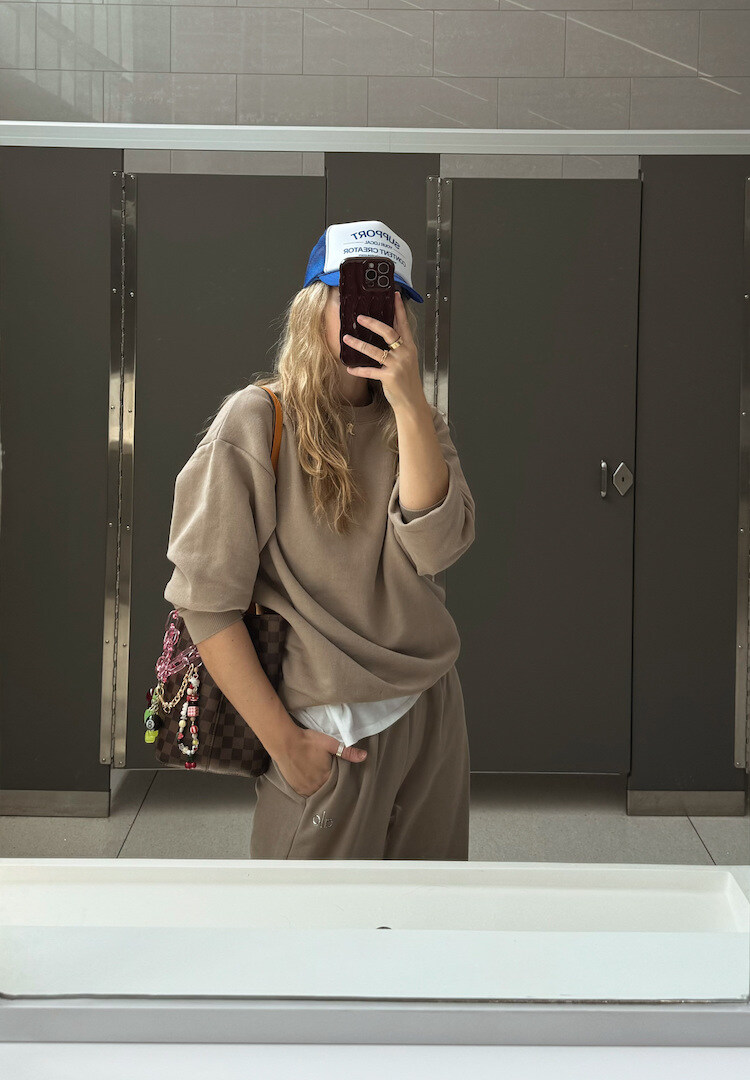
Hot take: I don’t think long-haul flights are that bad. At least, they’re okay as long as the kid behind you isn’t kicking your seat, the airline doesn’t run out of vegetarian meals, the turbulence doesn’t make you nauseous and the in-flight entertainment system actually works. Barring all that, I firmly believe that all a long-haul flier needs to get from Point A to Point B with their sanity intact is a pair of headphones and the ability to temporarily dissociate.
However, my skin would probably disagree. On my annual 24-hour flight from Melbourne to New York and back again, I often deplane with an uncanny resemblance to the Crypt Keeper. I literally look like every drop of moisture has been sucked out of me. My skin is dry, dull and disgusted with me. The Border Force officer is glancing suspiciously between me and my passport. I’m feeling insecure. No one’s happy.
Want to snoop inside the beauty regimes of other creatives? Head here.
I’m determined that my next long-haul flight will be different. When I disembark, I’ll be glowing, dewy, beautiful. In fact, I’ll look better stepping off the plane than I did boarding it. How? With help from the experts who know travel skincare struggles best – veteran flight attendant Tehlia Schwegler and dermatologists Dr Shreya Andric and Dr Deshan Sebaratnam.
Why do long-haul flights affect your skin?
First, let’s dive into the main reason long flights make our skin feel so yucky in the first place. Namely, the lack of humidity, which both Dr Shreya and Dr Deshan cite as the culprit behind dry skin and flare-ups of conditions like eczema, rosacea and dermatitis. “Long-haul flights can take a real toll on the skin. The low humidity in cabin air leads to transepidermal water loss, which can leave skin dehydrated, dull and more prone to sensitivity,” says Dr Shreya.
Over her six years as a flight attendant with a major international airline, Tehlia’s experienced tightness and flakiness due to the dry cabin air on her long-haul flights to Asia, Europe and the United States. She’s noticed that dehydration can trigger painful breakouts, too. “It’s like your skin is begging for moisture and rest.”
But dry air isn’t the only thing dulling your skin’s shine. Dr Deshan and Dr Shreya note that at high altitudes where planes fly, there’s more ultraviolet radiation. The oxidative stress from this UV exposure can compromise the skin barrier and accelerate signs of ageing. Additionally, changes in cabin pressure, recycled air and sleep disruptions can wreak havoc on your skin, leading to increased facial puffiness and more dramatic dark circles.
The perfect pre-flight skincare ritual
As with all things, failing to prepare is preparing to fail. Dr Shreya explains that what you do before your long-haul flight is just as important as what you do after takeoff. “A good pre-flight routine focuses on hydration and barrier support,” she says.
Before a flight, Tehlia does just that, beginning her skincare routine with a gentle, non-stripping cleanser, followed by a hydrating toner or essence. “I layer on a rich serum with hyaluronic acid and finish with a thick moisturiser,” she says. “I’ll also use Vaseline as an eye cream and a facial oil if it’s a particularly long flight.”
在 Instagram 查看这篇帖子
Flight attendants famously have to ‘look the part’ and makeup is a massive aspect of their grooming requirements. To nourish her skin even while wearing makeup, Tehlia opts to use only beauty products that have been developed for hydration or are endorsed by dermatologists.
Dr Shreya also recommends serums containing ingredients like hyaluronic acid or niacinamide to attract and retain moisture in the flight cabin. And, like any good dermatologist, she emphasises the importance of wearing your sunscreen.
Freshen up from your seat
Tehlia and Dr Shreya love hydrating facial mists with glycerin, rose water or aloe to soothe and keep skin plump in the air. A fine mist can refresh your skin without disturbing your skincare base. If you’re concerned about cleanliness, Tehlia recommends using a rescue spray that’s both antibacterial and anti-inflammatory.
Dr Shreya also enjoys reapplying a lightweight, hydration-focused serum mid-flight to maintain moisture balance and support skin elasticity. Because lips and eyes are the first to show signs of dehydration, both she and Tehlia carry a thick lip balm during travel to reduce dryness and protect delicate skin.
View this post on Instagram
It’s easy to focus on the face and forget about the rest of our skin but Dr Deshan encourages long-haul travellers to lock in the moisture on their hands with a urea-based cream that can counteract the cabin’s dehydrating atmosphere.
If you’re travelling overnight and want a boost, Dr Shreya says that a hydrating sheet mask can do wonders. “Masks might look silly but they’re a skin-saver on ultra-long flights,” Tehlia agrees.
Most importantly, don’t forget to be sun-safe! “At high altitudes, you are exposed to a lot of ultraviolet radiation,” Dr Deshan says, “so it’s important to use a broad-spectrum SPF 50+ sunscreen.”
Skincare beyond the products
Caring for your skin is about more than creams and serums. We’ve all heard about the idea of skincare from within, so it’s no surprise that both Dr Shreya and Tehlia agree that staying hydrated by drinking plenty of water is key, especially when flying. “Drink lots of water,” Tehlia says, “Seriously, drink way more than you think you need.”
They also recommend sticking with water as your beverage of choice for the duration of your flight, as excessive caffeine and alcohol can actually worsen dehydration. As a bonus, without the buzziness of coffee or tea, you may even get some rest, which can help your body and skin recover.
View this post on Instagram
“Rest is huge,” says Tehlia, “I always bring a silk sleep mask, silk pillow case and some noise-cancelling headphones to make it easier to wind down.”
Closing your window if you’re sitting in a window seat can have a twofold benefit. It can help you sleep, which Dr Shreya says will relieve stress and support your skin’s regeneration throughout the flight. And, as Dr Deshan notes, the sun’s rays can’t get through a closed window, saving you a day’s worth of UV damage.
Post-flight pampering
You’ve now reached your destination and you’re settling in. What now? First up, Dr Shreya recommends a gentle cleanse to remove any residual product, sweat and environmental grime. When she finally disembarks, Tehlia does a full double cleanse before pampering her skin with a soothing collagen sheet mask, nourishing night cream and gentle facial massage with a jade roller to reduce puffiness and boost circulation. “It’s like hitting reset,” she says.
View this post on Instagram
“Post-flight skincare should focus on soothing and restoring the skin barrier,” says Dr Shreya. “The goal is to reduce inflammation and rehydrate thoroughly, using a product with antioxidants like vitamin C or niacinamide to counteract any oxidative stress from the flight.”
For more on in-air skincare, head here.
This article A flight attendant’s skincare routine for long-haul flights, approved by dermatologists appeared first on Fashion Journal.
2025-06-05 11:56:00
#flight #attendants #skincare #routine #longhaul #flights #approved #dermatologists
Source link
















